Ziyu Guan
Beyond Single-Granularity Prompts: A Multi-Scale Chain-of-Thought Prompt Learning for Graph
Oct 10, 2025Abstract:The "pre-train, prompt'' paradigm, designed to bridge the gap between pre-training tasks and downstream objectives, has been extended from the NLP domain to the graph domain and has achieved remarkable progress. Current mainstream graph prompt-tuning methods modify input or output features using learnable prompt vectors. However, existing approaches are confined to single-granularity (e.g., node-level or subgraph-level) during prompt generation, overlooking the inherently multi-scale structural information in graph data, which limits the diversity of prompt semantics. To address this issue, we pioneer the integration of multi-scale information into graph prompt and propose a Multi-Scale Graph Chain-of-Thought (MSGCOT) prompting framework. Specifically, we design a lightweight, low-rank coarsening network to efficiently capture multi-scale structural features as hierarchical basis vectors for prompt generation. Subsequently, mimicking human cognition from coarse-to-fine granularity, we dynamically integrate multi-scale information at each reasoning step, forming a progressive coarse-to-fine prompt chain. Extensive experiments on eight benchmark datasets demonstrate that MSGCOT outperforms the state-of-the-art single-granularity graph prompt-tuning method, particularly in few-shot scenarios, showcasing superior performance.
Gradient Rectification for Robust Calibration under Distribution Shift
Aug 27, 2025Abstract:Deep neural networks often produce overconfident predictions, undermining their reliability in safety-critical applications. This miscalibration is further exacerbated under distribution shift, where test data deviates from the training distribution due to environmental or acquisition changes. While existing approaches improve calibration through training-time regularization or post-hoc adjustment, their reliance on access to or simulation of target domains limits their practicality in real-world scenarios. In this paper, we propose a novel calibration framework that operates without access to target domain information. From a frequency-domain perspective, we identify that distribution shifts often distort high-frequency visual cues exploited by deep models, and introduce a low-frequency filtering strategy to encourage reliance on domain-invariant features. However, such information loss may degrade In-Distribution (ID) calibration performance. Therefore, we further propose a gradient-based rectification mechanism that enforces ID calibration as a hard constraint during optimization. Experiments on synthetic and real-world shifted datasets, including CIFAR-10/100-C and WILDS, demonstrate that our method significantly improves calibration under distribution shift while maintaining strong in-distribution performance.
Enhancing Homophily-Heterophily Separation: Relation-Aware Learning in Heterogeneous Graphs
Jun 26, 2025Abstract:Real-world networks usually have a property of node heterophily, that is, the connected nodes usually have different features or different labels. This heterophily issue has been extensively studied in homogeneous graphs but remains under-explored in heterogeneous graphs, where there are multiple types of nodes and edges. Capturing node heterophily in heterogeneous graphs is very challenging since both node/edge heterogeneity and node heterophily should be carefully taken into consideration. Existing methods typically convert heterogeneous graphs into homogeneous ones to learn node heterophily, which will inevitably lose the potential heterophily conveyed by heterogeneous relations. To bridge this gap, we propose Relation-Aware Separation of Homophily and Heterophily (RASH), a novel contrastive learning framework that explicitly models high-order semantics of heterogeneous interactions and adaptively separates homophilic and heterophilic patterns. Particularly, RASH introduces dual heterogeneous hypergraphs to encode multi-relational bipartite subgraphs and dynamically constructs homophilic graphs and heterophilic graphs based on relation importance. A multi-relation contrastive loss is designed to align heterogeneous and homophilic/heterophilic views by maximizing mutual information. In this way, RASH simultaneously resolves the challenges of heterogeneity and heterophily in heterogeneous graphs. Extensive experiments on benchmark datasets demonstrate the effectiveness of RASH across various downstream tasks. The code is available at: https://github.com/zhengziyu77/RASH.
Discrepancy-Aware Graph Mask Auto-Encoder
Jun 24, 2025
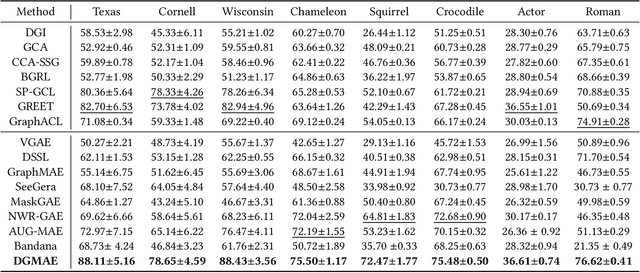
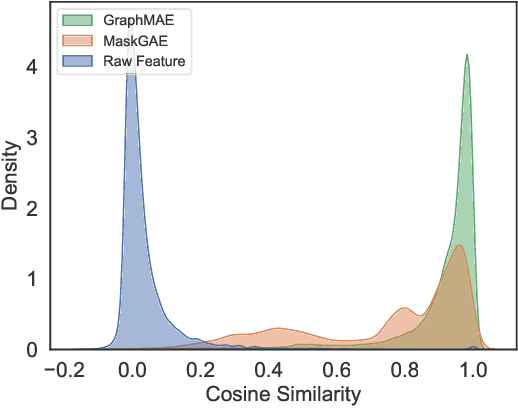

Abstract:Masked Graph Auto-Encoder, a powerful graph self-supervised training paradigm, has recently shown superior performance in graph representation learning. Existing works typically rely on node contextual information to recover the masked information. However, they fail to generalize well to heterophilic graphs where connected nodes may be not similar, because they focus only on capturing the neighborhood information and ignoring the discrepancy information between different nodes, resulting in indistinguishable node representations. In this paper, to address this issue, we propose a Discrepancy-Aware Graph Mask Auto-Encoder (DGMAE). It obtains more distinguishable node representations by reconstructing the discrepancy information of neighboring nodes during the masking process. We conduct extensive experiments on 17 widely-used benchmark datasets. The results show that our DGMAE can effectively preserve the discrepancies of nodes in low-dimensional space. Moreover, DGMAE significantly outperforms state-of-the-art graph self-supervised learning methods on three graph analytic including tasks node classification, node clustering, and graph classification, demonstrating its remarkable superiority. The code of DGMAE is available at https://github.com/zhengziyu77/DGMAE.
Conf-GNNRec: Quantifying and Calibrating the Prediction Confidence for GNN-based Recommendation Methods
May 22, 2025Abstract:Recommender systems based on graph neural networks perform well in tasks such as rating and ranking. However, in real-world recommendation scenarios, noise such as user misuse and malicious advertisement gradually accumulates through the message propagation mechanism. Even if existing studies mitigate their effects by reducing the noise propagation weights, the severe sparsity of the recommender system still leads to the low-weighted noisy neighbors being mistaken as meaningful information, and the prediction result obtained based on the polluted nodes is not entirely trustworthy. Therefore, it is crucial to measure the confidence of the prediction results in this highly noisy framework. Furthermore, our evaluation of the existing representative GNN-based recommendation shows that it suffers from overconfidence. Based on the above considerations, we propose a new method to quantify and calibrate the prediction confidence of GNN-based recommendations (Conf-GNNRec). Specifically, we propose a rating calibration method that dynamically adjusts excessive ratings to mitigate overconfidence based on user personalization. We also design a confidence loss function to reduce the overconfidence of negative samples and effectively improve recommendation performance. Experiments on public datasets demonstrate the validity of Conf-GNNRec in prediction confidence and recommendation performance.
AGMixup: Adaptive Graph Mixup for Semi-supervised Node Classification
Dec 11, 2024



Abstract:Mixup is a data augmentation technique that enhances model generalization by interpolating between data points using a mixing ratio $\lambda$ in the image domain. Recently, the concept of mixup has been adapted to the graph domain through node-centric interpolations. However, these approaches often fail to address the complexity of interconnected relationships, potentially damaging the graph's natural topology and undermining node interactions. Furthermore, current graph mixup methods employ a one-size-fits-all strategy with a randomly sampled $\lambda$ for all mixup pairs, ignoring the diverse needs of different pairs. This paper proposes an Adaptive Graph Mixup (AGMixup) framework for semi-supervised node classification. AGMixup introduces a subgraph-centric approach, which treats each subgraph similarly to how images are handled in Euclidean domains, thus facilitating a more natural integration of mixup into graph-based learning. We also propose an adaptive mechanism to tune the mixing ratio $\lambda$ for diverse mixup pairs, guided by the contextual similarity and uncertainty of the involved subgraphs. Extensive experiments across seven datasets on semi-supervised node classification benchmarks demonstrate AGMixup's superiority over state-of-the-art graph mixup methods. Source codes are available at \url{https://github.com/WeigangLu/AGMixup}.
* Accepted by AAAI 2025
Dynamic Evidence Decoupling for Trusted Multi-view Learning
Oct 04, 2024



Abstract:Multi-view learning methods often focus on improving decision accuracy, while neglecting the decision uncertainty, limiting their suitability for safety-critical applications. To mitigate this, researchers propose trusted multi-view learning methods that estimate classification probabilities and uncertainty by learning the class distributions for each instance. However, these methods assume that the data from each view can effectively differentiate all categories, ignoring the semantic vagueness phenomenon in real-world multi-view data. Our findings demonstrate that this phenomenon significantly suppresses the learning of view-specific evidence in existing methods. We propose a Consistent and Complementary-aware trusted Multi-view Learning (CCML) method to solve this problem. We first construct view opinions using evidential deep neural networks, which consist of belief mass vectors and uncertainty estimates. Next, we dynamically decouple the consistent and complementary evidence. The consistent evidence is derived from the shared portions across all views, while the complementary evidence is obtained by averaging the differing portions across all views. We ensure that the opinion constructed from the consistent evidence strictly aligns with the ground-truth category. For the opinion constructed from the complementary evidence, we allow it for potential vagueness in the evidence. We compare CCML with state-of-the-art baselines on one synthetic and six real-world datasets. The results validate the effectiveness of the dynamic evidence decoupling strategy and show that CCML significantly outperforms baselines on accuracy and reliability. The code is released at https://github.com/Lihong-Liu/CCML.
Aligning Multiple Knowledge Graphs in a Single Pass
Aug 01, 2024



Abstract:Entity alignment (EA) is to identify equivalent entities across different knowledge graphs (KGs), which can help fuse these KGs into a more comprehensive one. Previous EA methods mainly focus on aligning a pair of KGs, and to the best of our knowledge, no existing EA method considers aligning multiple (more than two) KGs. To fill this research gap, in this work, we study a novel problem of aligning multiple KGs and propose an effective framework named MultiEA to solve the problem. First, we embed the entities of all the candidate KGs into a common feature space by a shared KG encoder. Then, we explore three alignment strategies to minimize the distances among pre-aligned entities. In particular, we propose an innovative inference enhancement technique to improve the alignment performance by incorporating high-order similarities. Finally, to verify the effectiveness of MultiEA, we construct two new real-world benchmark datasets and conduct extensive experiments on them. The results show that our MultiEA can effectively and efficiently align multiple KGs in a single pass.
Adapt2Reward: Adapting Video-Language Models to Generalizable Robotic Rewards via Failure Prompts
Jul 20, 2024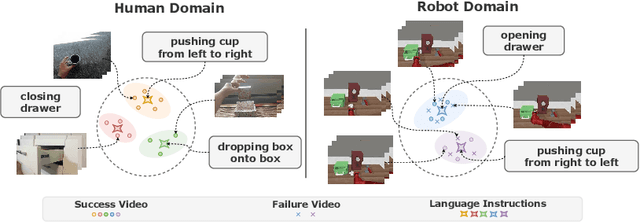
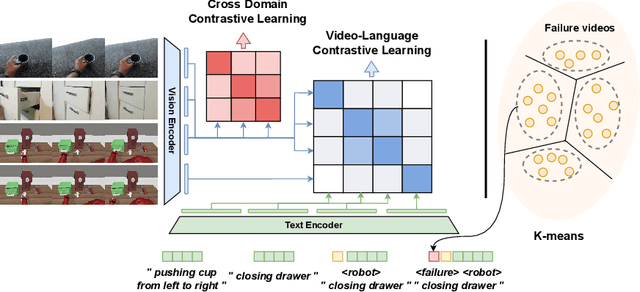
Abstract:For a general-purpose robot to operate in reality, executing a broad range of instructions across various environments is imperative. Central to the reinforcement learning and planning for such robotic agents is a generalizable reward function. Recent advances in vision-language models, such as CLIP, have shown remarkable performance in the domain of deep learning, paving the way for open-domain visual recognition. However, collecting data on robots executing various language instructions across multiple environments remains a challenge. This paper aims to transfer video-language models with robust generalization into a generalizable language-conditioned reward function, only utilizing robot video data from a minimal amount of tasks in a singular environment. Unlike common robotic datasets used for training reward functions, human video-language datasets rarely contain trivial failure videos. To enhance the model's ability to distinguish between successful and failed robot executions, we cluster failure video features to enable the model to identify patterns within. For each cluster, we integrate a newly trained failure prompt into the text encoder to represent the corresponding failure mode. Our language-conditioned reward function shows outstanding generalization to new environments and new instructions for robot planning and reinforcement learning.
Enhancing Criminal Case Matching through Diverse Legal Factors
Jun 17, 2024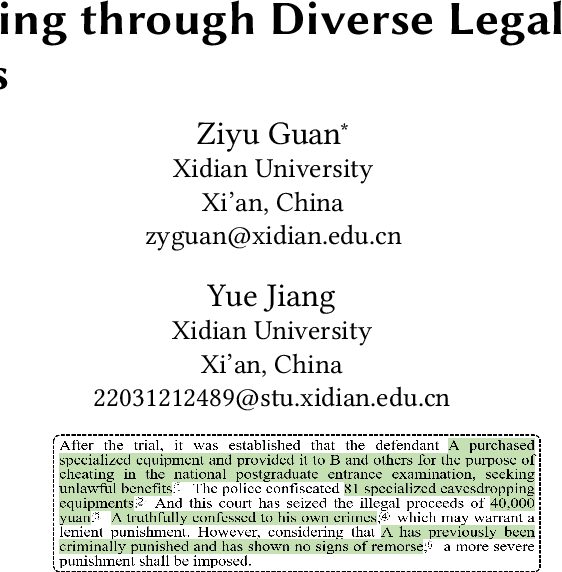
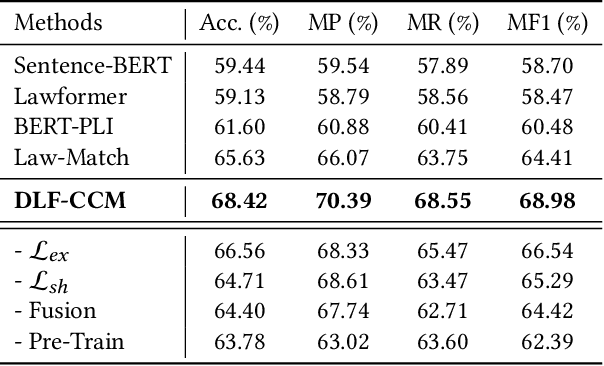
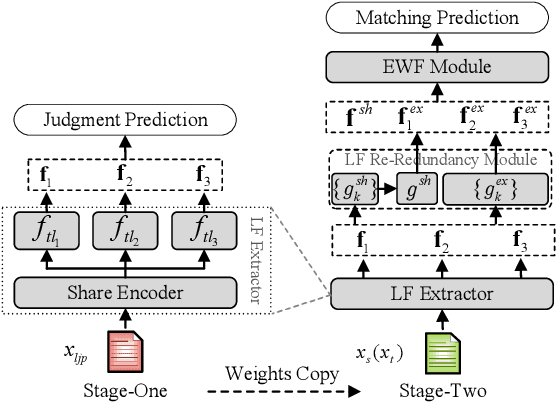
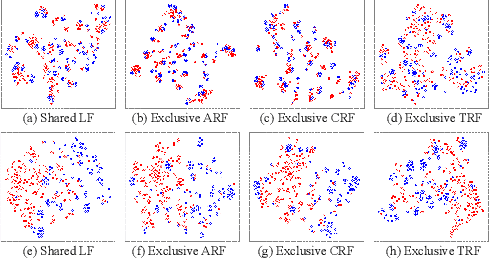
Abstract:Criminal case matching endeavors to determine the relevance between different criminal cases. Conventional methods predict the relevance solely based on instance-level semantic features and neglect the diverse legal factors (LFs), which are associated with diverse court judgments. Consequently, comprehensively representing a criminal case remains a challenge for these approaches. Moreover, extracting and utilizing these LFs for criminal case matching face two challenges: (1) the manual annotations of LFs rely heavily on specialized legal knowledge; (2) overlaps among LFs may potentially harm the model's performance. In this paper, we propose a two-stage framework named Diverse Legal Factor-enhanced Criminal Case Matching (DLF-CCM). Firstly, DLF-CCM employs a multi-task learning framework to pre-train an LF extraction network on a large-scale legal judgment prediction dataset. In stage two, DLF-CCM introduces an LF de-redundancy module to learn shared LF and exclusive LFs. Moreover, an entropy-weighted fusion strategy is introduced to dynamically fuse the multiple relevance generated by all LFs. Experimental results validate the effectiveness of DLF-CCM and show its significant improvements over competitive baselines. Code: https://github.com/jiezhao6/DLF-CCM.
 Add to Chrome
Add to Chrome Add to Firefox
Add to Firefox Add to Edge
Add to Edge